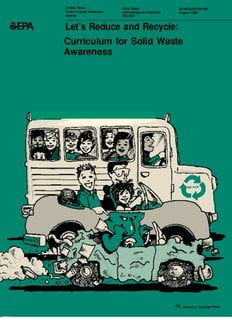Let’s Reduce and Recycle PDF, The lesson plans in this curriculum guide are based upon those that emerged as part of a public education campaign to promote recycling awareness in Somerville, Massachusetts, on December 1975.
The Somerville recycling program was funded by the U.S. Environmental Protection Agency (EPA) as a demonstration project to determine the feasibility of separating recyclable household waste from other waste prior to pickup.

Let’s Reduce and Recycle Pdf Download
INTRODUCTION
In the United States today we too often discard items that in earlier times would have been repaired or saved for other uses. In fact, many modern products are designed for a relatively short life followed by a speedy trip to the refuse pile.
As a nation, we currently produce about 180 million tons of municipal solid waste a year. This quantity of solid waste is enough to fill a convoy of garbage trucks stretching halfway to the moon!
How we can manage all of this waste in an environmentally sound manner is a complex and often controversial issue. Water pollution can result not only from dumping trash directly into the lakes, rivers, and seas but also from runoff and leaching from dumps.
See more: Let’s Reduce And Recycle: Curriculum For Solid Waste Awareness
Air pollution can result from faulty combustion and from decomposition gases surfacing in landfills. Fires, explosions, noxious odors, rodents, and disease also must be guarded against in landfills.
And direct contact with refuse can be dangerous in some cases to the public as well as to the waste collectors and processors (who, incidentally, have among the highest on-the-job injury rates of any occupation in the nation).
Our disposal options are steadily being reduced. The so-called “open dump” is now an anachronism; it has been gradually phased out because of its potentially unsafe and unsightly conditions. Although more than 70 percent of our garbage is currently buried in, landfills, more than one-third of the nation’s landfills will be full within the next few years.
Locating sites for new landfills (even facilities designed with state-of-the-art safeguards) is getting more difficult all the time due to economic constraints and public concern over [ human health and siting near neighborhoods.
Much of the opposition to landfills has been based on perceptions of possible pollution, health, and safety problems. In actuality, many of these problems can be avoided or controlled by proper siting, design, and operation of disposal facilities.
New regulations for landfill design ensure that newly constructed landfills will remain safe for many years into, the future. We are producing, however, an increasing amount of waste each year; by the year 2000, we are projected to generate 216 million tons per year.
Waste disposal costs are also soaring. Longer hauling distances from metropolitan areas to landfill sites and more stringent environmental regulations push costs upwards, as do general increases in labor costs and rising land values. In some areas of the country, it can cost as much as $100 per ton or more to dispose of waste.
Read Also: College & University Notes
Disclaimer:- Dev Library is not the owner of the books and neither does it create books. We just provide the links of the book for the rural and poor students who don’t afford to buy books. Those E-Books and Pdfs are already available on the internet. For any reason, if someone thinks that I’m violating any laws or if anyone has any issues regarding this, please feel free to Contact Us.

Hi, I’m Dev Kirtonia, Founder & CEO of Dev Library. A website that provides all SCERT, NCERT 3 to 12, and BA, B.com, B.Sc, and Computer Science with Post Graduate Notes & Suggestions, Novel, eBooks, Biography, Quotes, Study Materials, and more.








